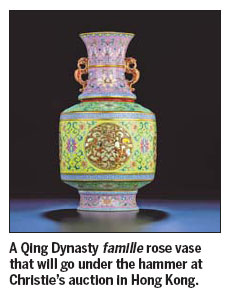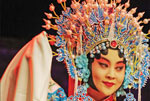Heritage
Rare ceramics at Christie's spring sales
Updated: 2011-05-10 08:00
By Lin Qi (China Daily)
Several important and rare ceramics will highlight Christie's spring sales in Hong Kong, from May 27 to June 1, among which a Qing Dynasty (1644-1911) famille rose vase deserves special attention.
The well-preserved vase from a private collector features reticulated outer walls and rotating, painted interiors. It is said to be an example of the superior craftsmanship of the imperial kilns during the reign of Emperor Qianlong (1736-96), as few reticulated revolving vases were successfully produced at that time in China.
In 2010, a delicate 40.6 cm vase, also dating to the Qianlong period, and similar in structure, fetched $87.01 million in London, setting the highest price ever paid for a Chinese work of art at public auction.
The vase to go under the hammer on June 1, is 38.1 cm, while the neck and inner cylinder are made into one piece, and the outer walls, base and foot form an envelope. A porcelain cone placed in the center between the bases of the outer and inner sections provides the pivot, on which the inner vase is able to rotate.
The artisans who produced the vase further pierced the outer shell to create a reticulated pattern, by which the decoration of the inner vase can be seen. It added a degree of difficulty to the task, because the reticulated roundels on the outer walls needed to be designed and balanced very carefully so that the exterior section would not distort or collapse during firing.
Another ceramic in the limelight is a Ming Dynasty (1368-1644) doucai stem cup.
 |
The doucai (a mix of blue underglaze and a colored overglaze) wares of Emperor Chenghua's reign (1465-87) have enjoyed universal admiration for more than five centuries. In the late 16th century, a collector had to pay as much as 100,000 taels (roughly 3,800 kg) of silver for a Chenghua doucai porcelain.
The stem cup was probably made during the latter period of Chenghua's rule, when the emperor's deep interest in Buddhism led to the manufacture of vessels decorated with Buddhist emblems, for instance, lotus flowers, which adorn the cup.
The cup was one of the few antiquities that survived a fire in the Forbidden City in 1923.
Other porcelains to be sold include a pair of famille rose jars and covers, a famille rose flower-patterned, double-gourd vase, both from the Qianlong period, and a Ming underglazed blue jar patterned with dragons and lotus flowers, which is from the Robert Chang Collection.
Ceramics of the Ming and Qing dynasties have always been sought-after purchases in the art market. Ming underglaze blue porcelains and Qing famille rose and falangcai (lacquer enamel) pieces, in particular, enjoy great popularity among collectors for their artistic and technical achievements, and keep creating sale records.
According to Beijing-based Artron Art Market Monitoring Center's report, five of the top 10 Chinese ceramics and works of art, ranked by their prices at 2010 autumn sales, were Qing famille rose and falangcai masterpieces.
On Sotheby's spring sales in Hong Kong in April, a falangcai vase with golden pheasants and a poetic colophon of Qianlong period was sold privately after the sale for HK$200 million ($25.74 million).
Ceramics made in the prime of the Qing era, during the reigns of Emperor Kangxi, Yongzheng and Qianlong, have created and maintained excellent value in the market.
China Daily
Specials

The song dynasty
There are MORE THAN 300 types of Chinese operas but two POPULAR varieties are major standouts

Sino-US Dialogue
China and the US hold the third round of the Strategic and Economic Dialogue from May 9-10 in Washington.

Building communities
American architect John Portman and his company have developed more than 30 projects across China.